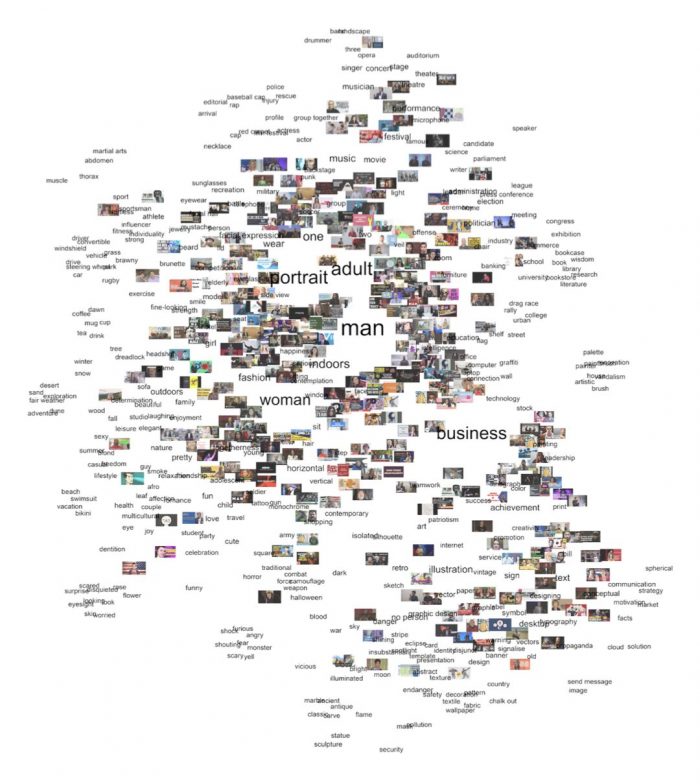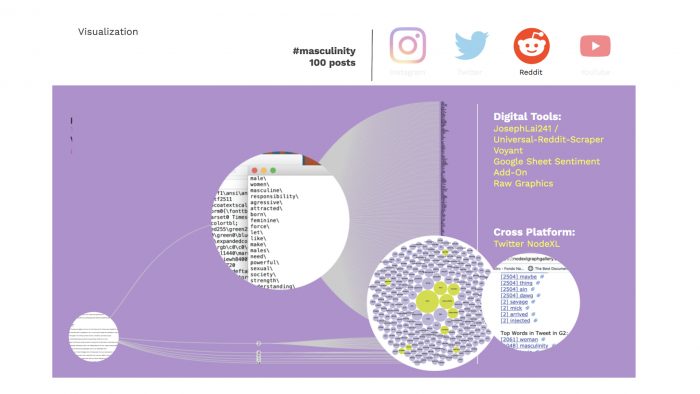Project: Cross-Platform Digital Networks
Subproject title: Masculinity
Team members (alphabetical order): Fernanda Benquerer Costa, Alexandra Deem, Marcia Lisboa, Saide Mobayed, Paulina Sierra.
Key Findings
Research Question
How is masculinity being represented through different digital platforms use-cultures?
Query Design & Visual Protocol
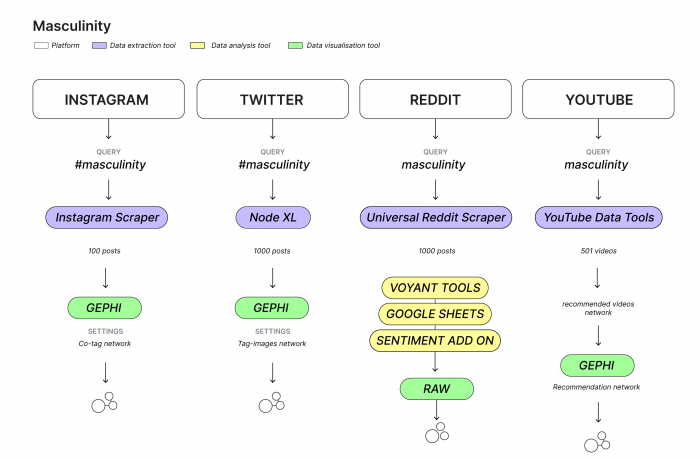
- YouTube
Data extraction from YouTube Data Tools (DMI)
- Video List
- Search query: “masculinity”
- Published from Jan 29, 2019, to Jan 29 2020
- Rank by the amount of likes
- The script has created a file with 500 rows
- Master file created
A master file was created with all the information scraped obtained from this YouTube tool: https://tools.digitalmethods.net/netvizz/youtube/mod_videos_list.php
Raw graph
In order to visualize which video had the most views (and make a cross channel linkage), we used Raw Graphs. Paulina edited it on Illustrator to make it more aesthetic:
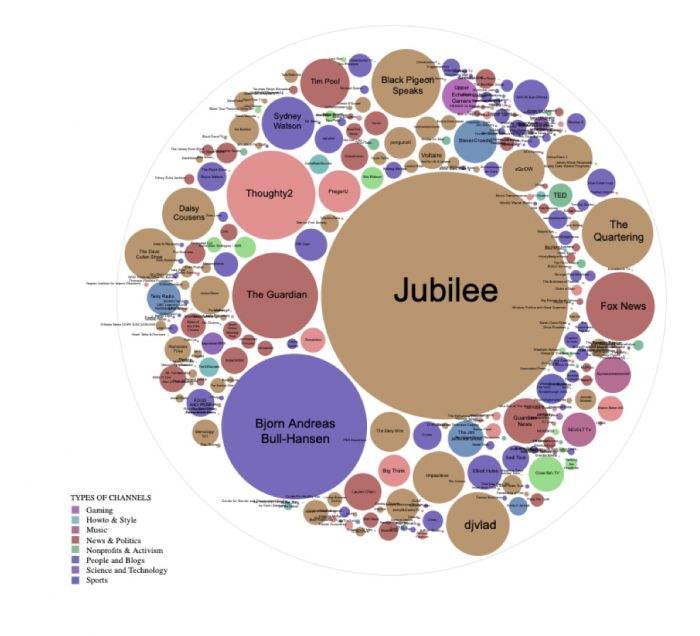
Image API from YouTube:
- The images were extracted with the use of YouTube tools.
- Clarify was used to get the images (Thumbnails). This process was done by Beatrice, who has vast experience in this matter.
- A visual network was created with this extracted material.
Video Network
Data extraction from YouTube Data Tools (DMI)
- Video Network
- Search query: manhood
- No specific timeframe
- Rank by relevance
- The script has created a net with 3677 videos from 50 seeds.
- We started by using InstaScraper to scrape 100 posts using the query masculinity. This yielded a relatively small network that was nonetheless interesting given that it separated into 5 distinct clusters related to Italian men’s fashion, dating/feminism/anti-feminism, men’s sexuality, men’s fashion (English, materials), and workout culture.
- We also generated a network using 4 seed queries/hashtags (masculinity, manhood, realmen, toxicmasculinity) that also had 100 posts each. This was obviously bigger than the other and had less distinct clusters. One observation was that hashtags clustering around toxicmasculinity and hashtags clustering around realmen were at opposing ends of the network.
- We then asked what would happen if we scraped more posts and increased the number to 1000 using seeds masculinity, realmen, toxicmasculinity, etc. This generated an extremely dense network that was largely impossible to read in Gephi. We determined that we should either keep the same number of seeds and decrease number to 300 or choose only masculinity and keep it at 1000. Nevertheless, because of its issues with InstaScraper, we were unable to actually query these parameters and so our visuals are drawn mostly from the initial 100 post query related to #masculinity
- We scraped Twitter for the hashtag masculinity with NodeXL, and tried to get all 18000 tweets the platform allows. However, it became a very large file hard to work with.
- Then, we tried alternatives. The image presented for the group is of 1000 tweets with the hashtag masculinity, also built with NodeXL. We got another network with over 11000 tweets.
- A limitation of this platform is the amount of data Twitter allows to scrape.
JosephLai241 / Universal-Reddit-Scraper
The results of the scraper gathered the following informa@on of the r/masculinity reddit and
top subreddits:
Title | Comments | Upvotes

From that informa@on it seemed interes@ng to find the word frequency in all of the comments so Voyant was the next digital tool that was used next.
The original cvs file was modified with another column with the individual 10 top terms by frequency results were gathered in a text file.
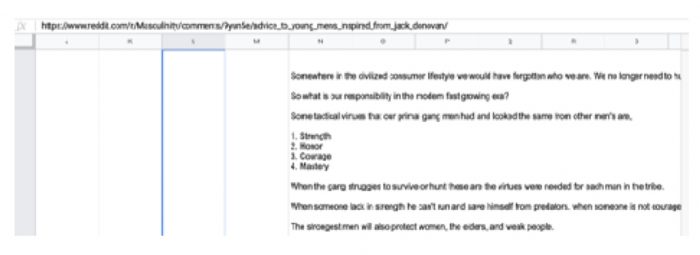
As the results were not significant enough, to map them, some Raw Graphs were created. A way to go forward was suggested to try to find something significant from the informa@on with Google Sheet SenAment Add-On but the results were not polarized enough to become interes@ng.
NodeXL Twitter
Interestingly, the data by itself to become meaningful, could either go towards doing the same process with femininity as means to create a more cohesive polarized network or in terms of the research protocol, crossing the informa@on with the other platforms, one such way is with TwiTTer Node XL results from the same #masculinity scrape.
- Wikipedia
With the use of the “SeeAlsology” tool https://densitydesign.github.io/strumentalia-seealsology/ I searched the following concepts connected to masculinity which were then uploaded to Gephi to create a semantic network.
https://en.wikipedia.org/wiki/Masculinity
https://en.wikipedia.org/wiki/Toxic_masculinity
https://en.wikipedia.org/wiki/Man
https://en.wikipedia.org/wiki/Hegemonic_masculinity
https://en.wikipedia.org/wiki/Hypermasculinity
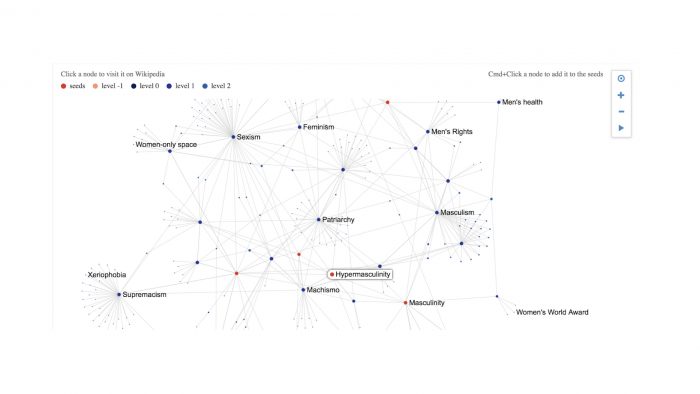
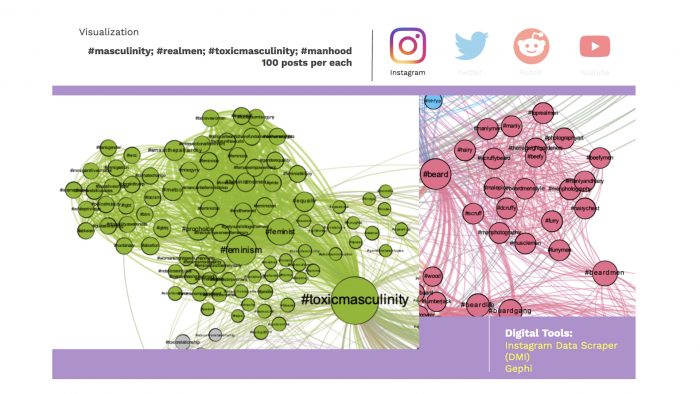
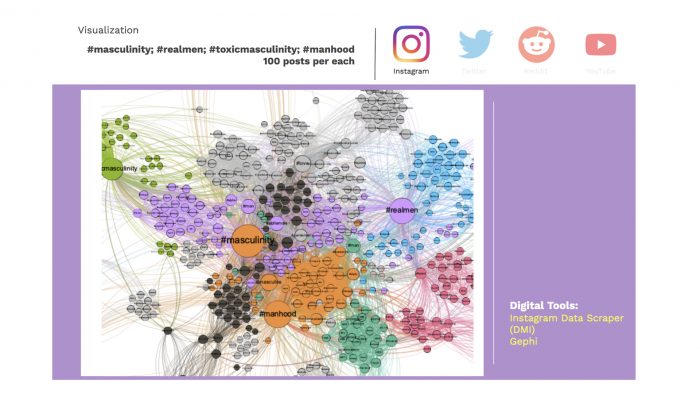
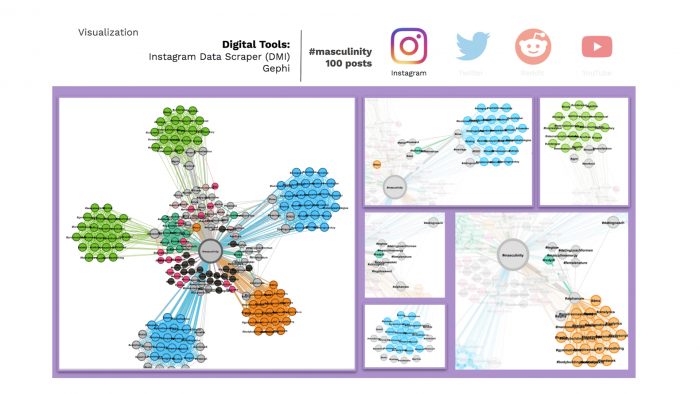
Hashtag engagement on Instagram: #masculinity and #masculinity; #realmen; #toxicmasculinity; #manhood
Hashtag engagement on Twitter: #masculinity
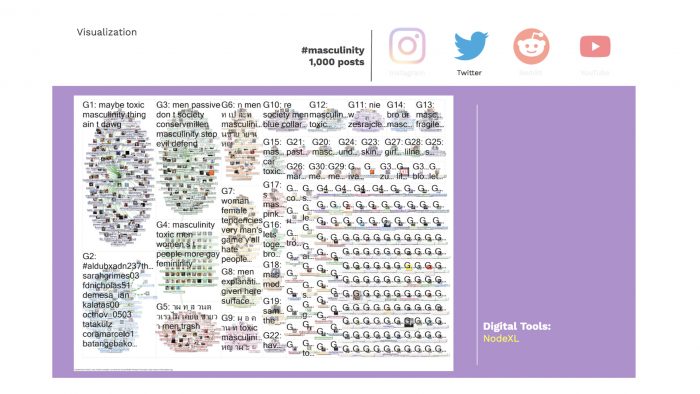
Video network of “manhood” on YouTube
-
- First division is between green and violet cluster in the top, and blue and grey cluster on the button;
- Peripheral polarization in both sides. Three kinds of videos: religious groups, self-help and conferences or TEDs related to manhood (including different subjects, such as the titles “Let’s talk about porn” and “How to learn any language in six months”);
- Titles suggest behaviour
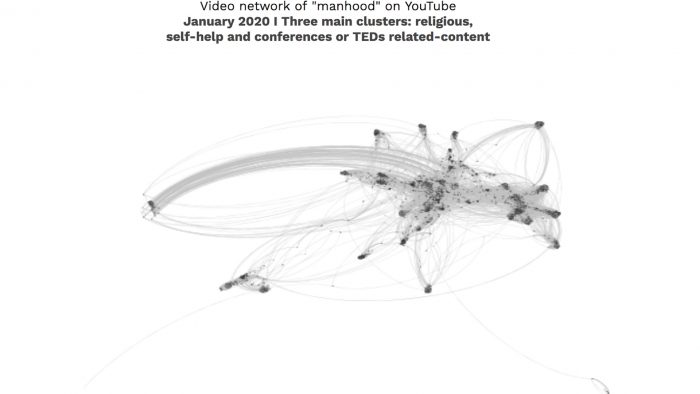
1) Cluster distribution is widely spread, with multiple polarization:
1.1) The first division is between 18 clusters at the top (including five closely connected clusters, near the center of the graph) and 11 clusters at the bottom (including the midterm cluster).
1.2) peripheral polarization on both sides. Our analysis identified five main approaches: religious discourse, dissemination of self-help topics, militant positioning of different matrices, scientific or academic affairs, and advertising.
2) At the midterm there is a small cluster composed of keynote presentations, meetings, students services and academic affairs.
3) In the periphery, the graph highlighted:
3.1) three very close clusters containing titles that support stereotypes of masculinity, such as: “Make men masculine again”, “15 sighs you are an alpha male”, “Are you a wolf or a sheep?”. However, one of them shows predominantly self-help titles, and is connected to three clusters based on religious theme.
3.2) There are two common features present in several clusters: conferences or TEDs, and the list format (Eg: “8 lessons in manhood from the vikings”).
3.3) Although there is a prevalence of religious themes in the clusters positioned on one side of the graph, the subject is also identified in other clusters.
3.4) Militant positions can be observed in different clusters. For example: the TED “Let’s talk about porn”, presented by an anti-porno movement organizer.

Image-label network of “manhood” image thumbnails on YouTube (computer vision API-based net)
